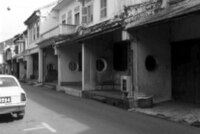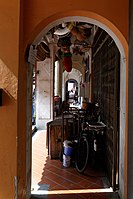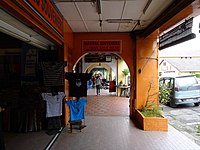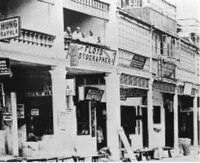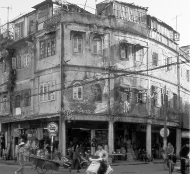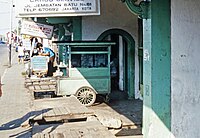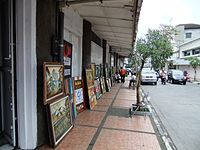Five-foot way

A five-foot way (


The term "five-foot" describes the width of the covered sidewalks.
As the name implies, five-foot ways may have a minimum width of five
History
The requirement for arcades in urban plans may be found as early as 1573 in the Royal Ordinances by Philip II of Spain.[3]
Batavia
-
Batavia street-scape illustrated in c.1760.
-
Kaki lima in Kota, Jakarta, c.1990.
-
Kaki lima in Melaka, c.1990.
When the
Singapore
In 1819, when Raffles founded modern Singapore, and it was in Singapore that the five-foot way became firmly established as an architectural feature of the region, he included this and other details in his Town Plan of 1822.[7] Raffles issued a set of instructions on how the new colony may be organised in his plan for Singapore in 1822. He stipulated that the buildings in the newly established colony should be uniform, and should be built of brick and tiles to reduce fire risks. He added that:
... a still further accommodation will be afforded to the public by requiring that each house should have a verandah of certain depth, open at all times as a continued and covered passage on each side of the street.[8]
This became the five-foot way, and this feature of
-
View of Singapore c.1845, shophouses with arcades can be seen in this drawing by John Turnbull Thomson.
-
A five-foot way in Singapore
-
A five-foot way in Singapore
Other Straits Settlements
Ordinances and by-laws requiring such verandah walkways were then enacted from the mid-19th and early 20th century in the Straits Settlements and Malayan towns, for example, the 1884 building by-laws introduced by Frank Swettenham in the rebuilding of Kuala Lumpur provided for the inclusion of 5-foot passageways beside the road.[12] However, the term "five-foot way" was not specifically mentioned in such ordinances and by-laws, rather words as arcade, verandah or verandah-way or five-foot-path were used. The term may have been coined by builders in response to the minimum width of the walkway. The walkway would become an integral feature of many settlements in neighbouring British colonies in the Malaya peninsula, and by the later half of the 19th century became a feature of the distinctive "Strait Settlement Style" buildings.[5] It is still commonly found in the towns and cities of Malaysia. Although it was originally a feature colonial-era buildings, many buildings in the post-colonial era in Malaysia still incorporated a sheltered walkway, although not necessarily in the form of an arcade.
-
Shophouses in Penang with a five-foot way
-
A tiled five-foot way in Penang
-
A five-foot way inKuala Trengganu, Malaysia
-
A five-foot way in Kuching, Sarawak
Southern China, Taiwan and Hong Kong Colony
The Five Foot Way or Verandah regulation was also applied for town planning in
-
Verandah in Hong Kong Colony, c. 1890.
-
Qílóu in Guanzhou, c. 1990.
Southeast Asia
This architectural feature also spread to other South East Asian countries, such as
It remains a prominent element in the architecture in Singapore and Malaysia.
Communal Kaki Lima

-
Roofed Walkway in Lukang, Taiwan, c.1900.
-
Roofed Walkway in Peng-Chau, Hong Kong, 1996.
Kaki Lima in Indonesia
The Indonesian usage of kaki lima is interchangeable with trotoar (from
-
Kaki Lima in Pecinan, Semarang, 1991.
-
Two Wheels Kaki Lima in Kota, Jakarta, 1990.
-
Kaki lima or five-foot way along Braga Street in Bandung, Indonesia, occupied by street artist selling paintings
See also
- Overhang (architecture)
- Portico
- Verandah
References
- ^ a b Naidu Ratnala Thulaja. "Five-foot-way traders". Singapore Infopedia. National Library Board.
- ^ ISBN 9781462916504.
- JSTOR 41493367.
- ^ Hideo Izumida (2005). "Kaki Lima as Contesting Space between European and Asian Values". Proceeding of International Conference of Malay Architecture as Lingua Franca.
- ^ JSTOR 41486189.
- ^ Suryatini N. Ganie (19 December 2010). "The 5 feet story of Thomas Stamford Raffles". Jakarta Post.
- ISBN 9780700715848.
- ^ Charles Burton Buckley (1902). An anecdotal history of old times in Singapore. Singapore, Printed by Fraser & Neave, limited. p. 84.
- ^ Hideo Izumida (July 1990). "Singapore's Town Planning and Shop-house; Historical Study on the Colonial Cities and Architecture in Southeast Asia Part 1". Journal of Architecture and Planning (Transactions of AIJ) (in Japanese): 161–175.
- ISBN 9780313377433.
- ISBN 9789971697679.
- ISBN 9789835203626.
- ^ Hideo Izumida; Huang Chun Min (April 1994). "Typology of Roofed Terraces and Covered Continuous Walkways: A study on Colonial Cities and Architecture of Southeast Asia Part 2". Journal of Architecture and Planning (Transactions of AIJ) (in Japanese): 145−153.
- ^ Jun Zhang (2015). "Rise and Fall of the Qilou: Metamorphosis of Forms and Meanings in the Built Environment of Guangzhou" (PDF). Traditional Dwellings and Settlements Review. 26 (2): 26–40. Archived from the original (PDF) on 18 October 2015.
- ^ Hideo Izumida (May 2003). "Settlement Improvement in the Former Hong Kong Colony According to Reports by Osbert Chadwick, A Study on Colonial Cities and Architecture in Southeast Asia Part 3". Journal of Architecture and Planning (Transactions of AIJ) (in Japanese): 179–189.
Sources
- 1. Johann Friedrich Geist, Arcades The History of a Building Type, 1989, ISBN 0-262-07082-0
- 2. Doren Greig, The Reluctant Colonists Netherlanders Abroad n the 17th and 18th centuries, 1987, ISBN 90-232-2227-X
- 3. Jean Gelman Taylor, The Social World of Batavia European and Eurasian in Dutch Asia, 1983, ISBN 0-299-09470-7
- 4. Hideo Izumida, Chinese Settlements and China-towns along Coastal Area of the South China Sea: Asian Urbanization Through Immigration and Colonization, 2006, ISBN 978-89-5933-712-5(Korean version)



